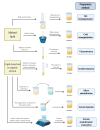Solid Lipid Nanoparticles as Carriers of Natural Phenolic Compounds
- PMID: 33076501
- PMCID: PMC7602534
- DOI: 10.3390/antiox9100998
Solid Lipid Nanoparticles as Carriers of Natural Phenolic Compounds
Abstract
Phenolic compounds are one of the most widespread classes of compounds in nature, with several beneficial biological effects being associated with their anti-oxidant and anti-carcinogenic activities. Their application in the prevention or treatment of numerous chronic diseases have been studied, but a major drawback is still the low bioavailability of these compounds, as well as their instability towards pH, temperature, and light in some cases. Nanotechnology has emerged as an alternative to overcome these limitations, and the use of lipidic encapsulation systems is a promising technique to achieve an efficient drug delivery, protecting molecules from external factors and improving their bioavailability. In this review, solid lipid nanoparticles and nanostructured lipid carriers are highlighted as an important tool for the improvement of the bioavailability and stability of natural phenolic compounds, including their preparation methods and functionalization approaches and the discussion of several applications for putative use in cosmetic and pharmacologic products.
Keywords: bioactivity; chemical stabilization; nanostructured lipid carriers; phenolic compounds; solid lipid nanoparticles.
Conflict of interest statement
The authors declare no conflict of interest.
Figures





References
-
- Billot J. Evolution des composes phénoliques au cours de la maturation de la Poire Passe-Crassane. Physiol. Vég. 1983;21 doi: 10.20870/oeno-one.1972.6.2.2058. - DOI
-
- Shipp J., Abdel-Aal E.-S. Food Applications and physiological effects of anthocyanins as functional food ingredients. Open Food Sci. J. 2010;4:7–22. doi: 10.2174/1874256401004010007. - DOI
Publication types
Grants and funding
LinkOut - more resources
Full Text Sources
Other Literature Sources

